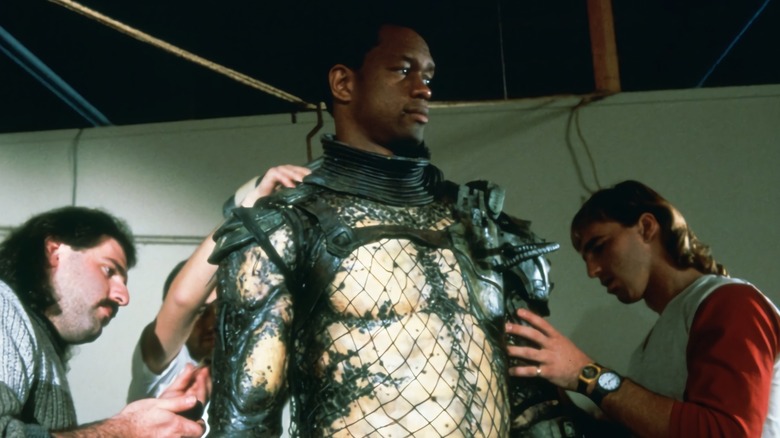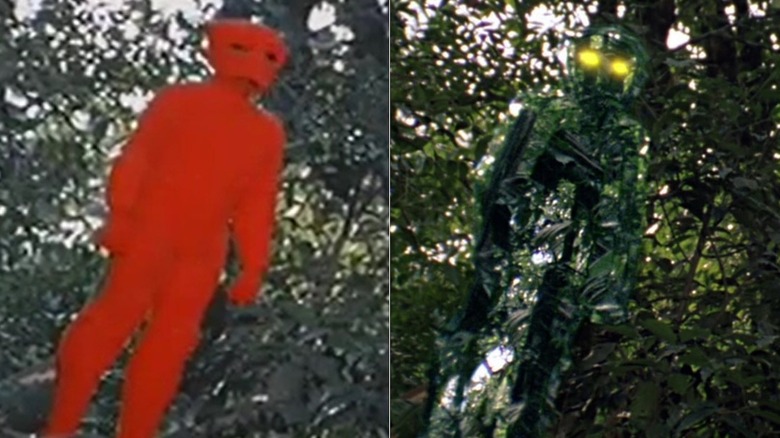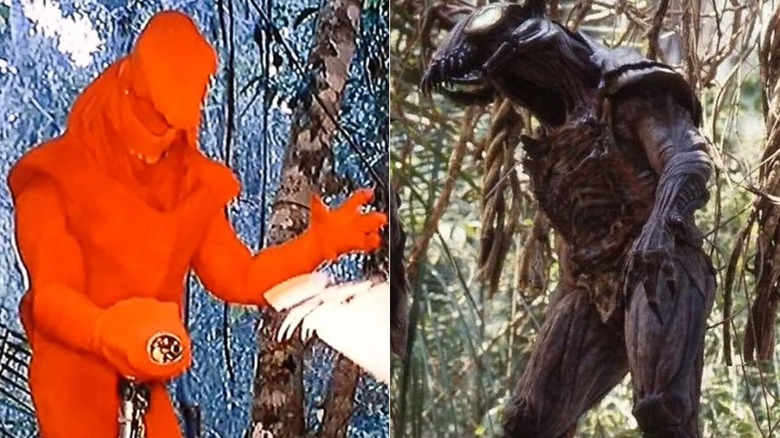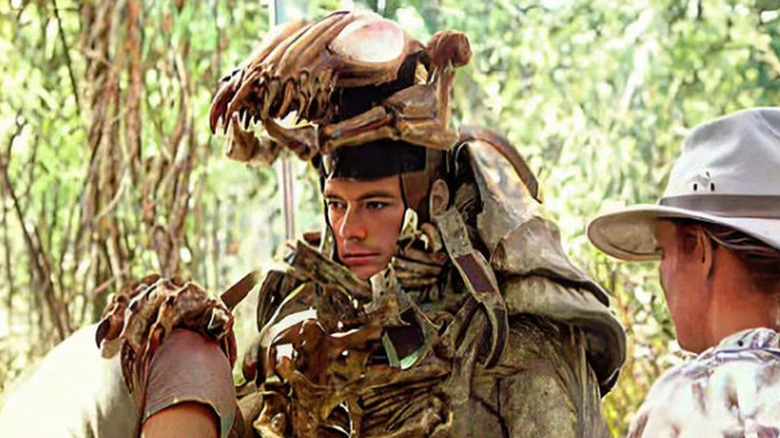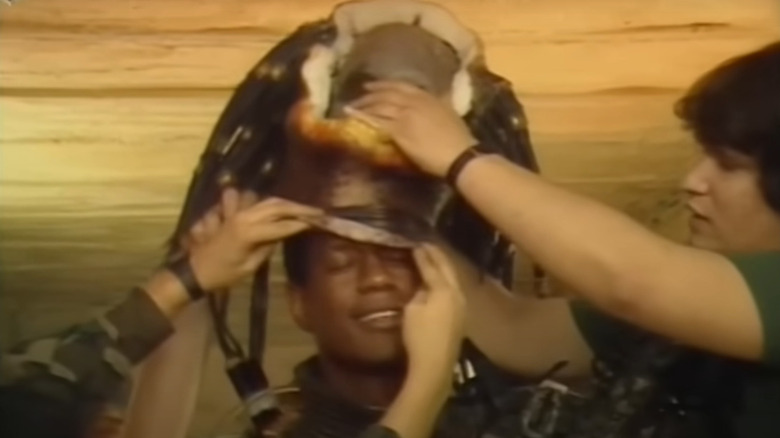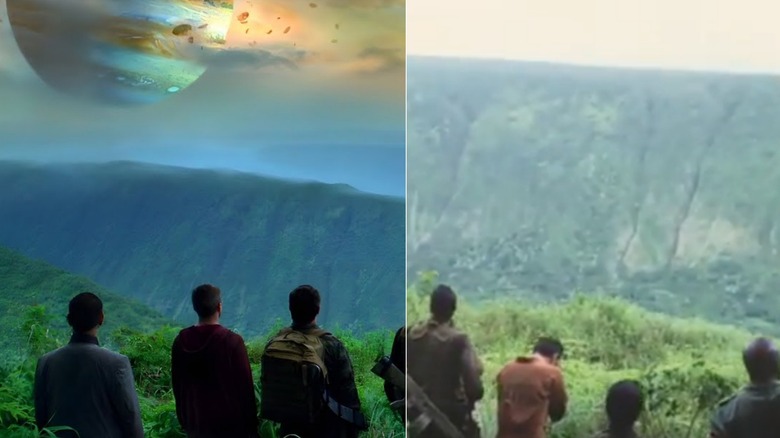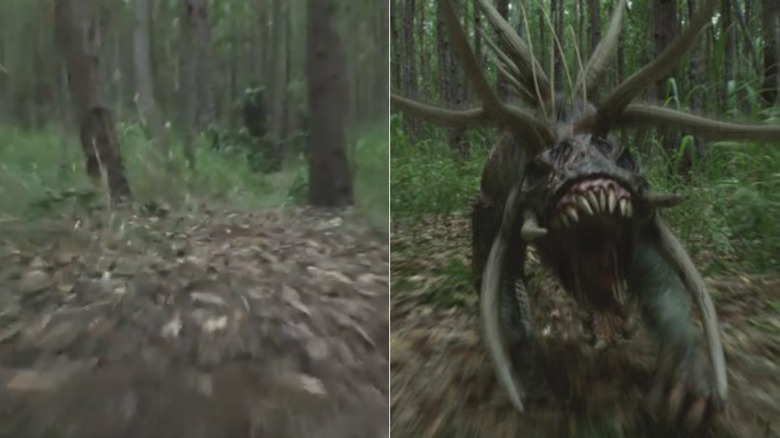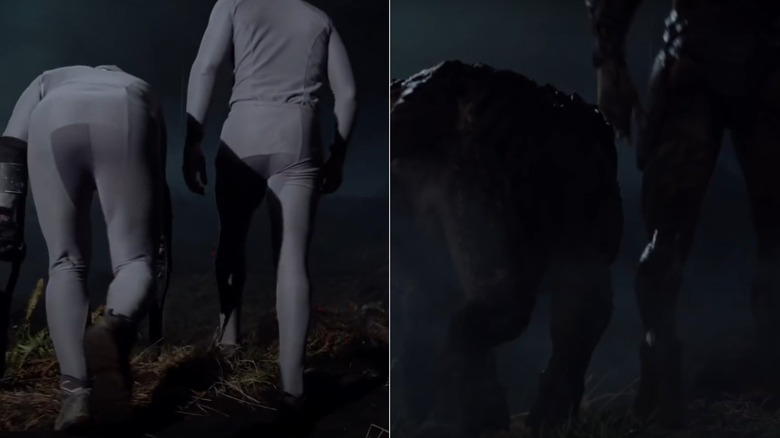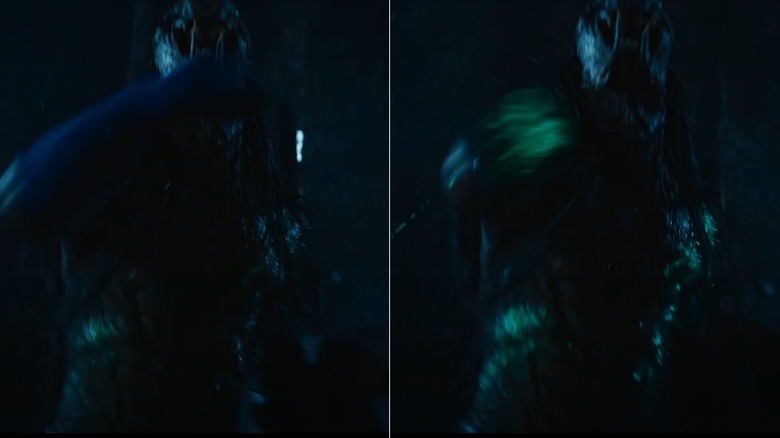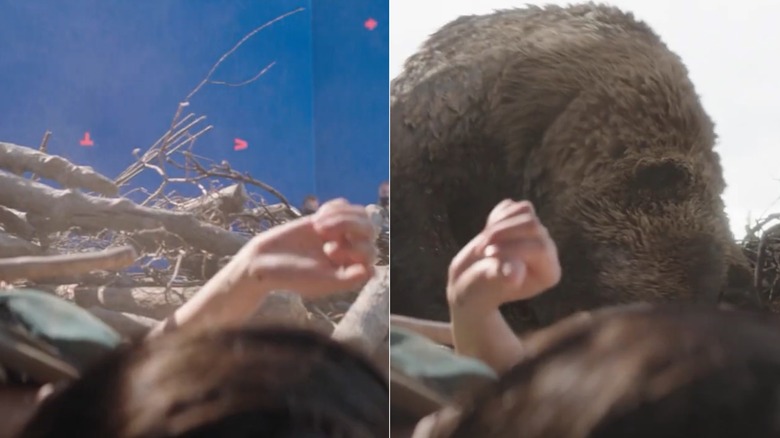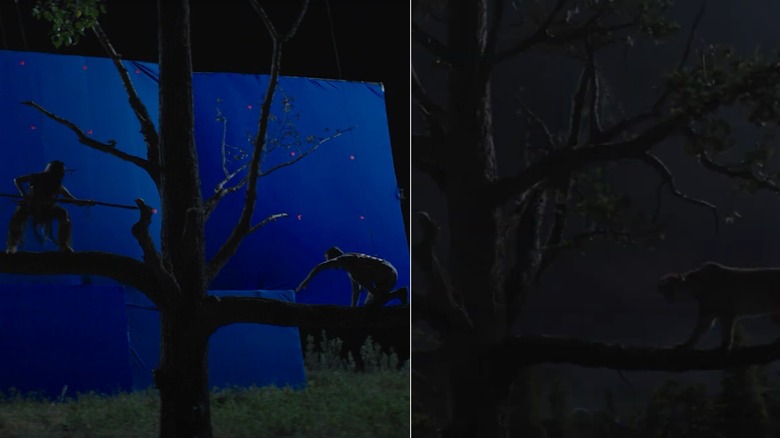What The Predator Movies Look Like Without Special Effects
The Predator is one of the most iconic characters in the history of big screen science fiction. The first film in the long-running "Predator" franchise, 1987's "Predator," has one of the best switcheroo premises ever, starting out as a tough guy ensemble flick before morphing into a sci-fi slasher/horror film in the second half. The movie also helped solidify Arnold Schwarzenegger as a box-office draw after his previous turns in 1982's "Conan the Barbarian" and 1984's "The Terminator."
While it was an arduous shoot, the film nonetheless became a massive success, which led to multiple comic book crossovers, toy lines, video games, and, of course, film sequels. The entire Predator story includes 1990's "Predator 2," which is set in Los Angeles (a concrete jungle this time!) and is led by "Lethal Weapon" star Danny Glover; 2010's "Predators," which stars Adrian Brody as a U.S. Special Operations Forces veteran stuck on an alien planet; 2018's "The Predator," a horribly botched sequel written and directed by Shane Black, who featured (albeit briefly) in the original film; and 2022's "Prey," which is set in 1719 and follows the badass Indigenous warrior Naru (Amber Midthunder), the first female protagonist in the series. There were also two "Alien vs. Predator" films between the second and third entries, but the less said about those, the better.
All the "Predator" films involved a lot of visual effects work, even the early entries in the franchise. What did these movies look like without the special effects? Scroll on to find out.
A goofy red cloth suit was used for the Predator's iconic cloaking effect
1987's "Predator" was filmed before the explosion of CGI, back when things that are considered rudimentary today were still difficult to achieve. When it came time to create the visual effect of the Predator stalking his potential victims in the jungle using his cloaking device, the visual effects team — led by supervisor Joel Hynek — had to get creative. Hynek had a lightbulb moment when he remembered a commercial that his team had previously worked on.
"We had done a commercial for Southern Bell where we had a person in a red suit and they were holding a green orb against the blue screen," he explained to VFX Blog. So they thought, "'Okay, we'll put a guy in a red suit and we'll run around in the jungle because the jungle's green and the sky's blue,' and so we tried it. We tried everything we could think of by pulling mattes off of that red suit. Sort of like blue screen in reverse, where your subject is the screen and the foreground is actually the background."
It looks borderline ridiculous when you look at the before-and-after images of the Predator in these scenes, but they became some of the most iconic shots in the whole film, so Hynek's approach was most definitely justified. In fact, the scenes in which the Predator is using his cloaking device still hold up pretty well today, so it's no wonder the effect was considered a major achievement back then.
The original Predator suit was a nightmare to work with
The Predator is known for its iconic design, which came by way of famed makeup artist Stan Winston. However, Winston and his studio weren't the first to be contacted about designing the Predator. The effects house Boss Film Studios created the original rubber Predator suit, though they warned producers that the design would be impractical for shooting on location. "They said, 'Here's what we want you to make.' What they needed was a character with backward bent reptilian legs, extended arms... and they wanted to shoot on the muddy slopes of Mexico in the real jungles," Steve Johnson, who took charge of the first suit build, said in a featurette. "It was virtually physically impossible to do. I told them it wouldn't work."
Director John McTiernan later stated in the documentary "If It Bleeds We Can Kill It" that the original Predator looked awful on camera due to how restrictive the original suit was for the actor. "It was impossible to move and it looked terrible," he said. McTiernan did shoot a couple of scenes with the insectoid design before calling up the studio to request more time and money to get it right. Luckily, after McTiernan showed the studio heads the goofy costume, they agreed and let the director take a break in filming so the alien antagonist could be re-designed from the ground up. Stan Winston and his team were brought in and they saved the day, turning the Predator from a corny-looking bug puppet into a terrifying extra-terrestrial killer.
Jean-Claude Van Damme played the original Predator - until he got fired
What many people might not know is that, before getting famous, action star Jean-Claude Van Damme played the original Predator. That is, the Predator with the insectoid design that looked utterly ridiculous. While the director and producers hated the initial rubber alien suit, Van Damme arguably hated it even more. The actor reportedly misunderstood the assignment, believing the role would allow him to show off his martial arts skills and make him a star. When he got to the shoot, he soon realized that he was going to be a glorified stuntman, since the suit didn't allow him to show his face or his acrobatic abilities.
Van Damme did his best to incorporate his kickboxing skills into the role, but this apparently annoyed producer Joel Silver. According to VFX supervisor Joel Hynek, it all came to a head when Silver confronted Van Damme. "I'll never forget being in Joel Silver's trailer and he wanted to put the word out, he wanted to talk to Van Damme," Hynek told VFX Blog. "So Van Damme comes into the trailer and Joel says, 'Look. You can not keep doing that kick. The Predator is not a kick boxer.' And Van Damme said, 'No I have to do that. He must do that.' Then Joel Silver said, 'Well forget it then. You're out of here. Goodbye.'"
This was probably for the best. The crew got a chance to regroup while a better Predator suit was designed, and producers were able to hire an actor more willing to play the role as written. Van Damme went on to make 1994's "Street Fighter" and carve out a career for himself as an action movie hero, so all's well that ends well.
Gentle giant Kevin Peter Hall replaced Jean-Claude Van Damme as the Predator
After the new and improved design for the Predator suit was made, the next step was casting. 7'4" actor Kevin Peter Hall was eventually cast in the role. His height and physical prowess had him towering over the himself-large Arnold Schwarzenegger, making their final confrontation at the climax of the film much more believable than it probably would have been with Jean-Claude Van Damme as the Predator.
The cast and crew had nothing but kind things to say about Hall, with Stan Winston even referring to him as a "wonderfully soft-hearted, intelligent, poetic, giant of a man" in a behind-the-scenes featurette. Despite his imposing stature, Hall was a genuine actor who actually put a lot of thought into who the Predator was. He said: "You work on the inner things that are going on in the character, just like you would with any character, in the suit or out of the suit."
Hall would return for 1990's "Predator 2" as a different Predator and he even made an appearance outside of the costume as the helicopter pilot that picks up Schwarzenegger's Dutch at the end of the first film, which was a nice touch — he contributed so much to the movie, so it was only right that his actual face should be in it, even if it was just briefly.
Digital matte paintings were used to create alien landscapes in Predators
Matte paintings are nothing new in filmmaking. In fact, this old technique can be traced back to the silent movie era, with the first matte painting being used in 1907's "Missions of California." Essentially, a matte painting is an image used to extend or alter the background of a scene. Back in the early days of film, matte paintings were either large pieces of art that were present on set or smaller paintings done on glass panes which were then composited on top of the previously filmed footage in editing (or, less regularly, the pane of glass was placed carefully in front of the camera and filmed on the day).
Nowadays, digital matte paintings are a lot more common. Not only is there more freedom in terms of movement — whether it's camera movement or the background itself moving — but it's also easier to rotoscope actors and other parts of the scenery more easily. Not that there aren't earlier examples of rotoscoping actors and environments into a non-digital matte painting, but it was a lot more costly and arduous to do it back then. So, it probably won't surprise you to learn that the matte painting used in 2010's "Predators" was of the digital variety.
In the film, Adrian Brody's disgraced mercenary Royce finds himself on a topical, forest-covered alien world alongside a bunch of other specialized killers, where they're hunted by Predators. Producers wanted viewers to know that this was a totally different galaxy, and they opted to use a digital matte painting to create an otherworldly horizon to drive that point home. It was created by the VFX house Hybride, which was no stranger to sci-fi/horror blends at this point, having previously worked on Guillermo del Toro's "Mimic."
CGI Hell-Hounds were added to location plates in Predators
Despite CGI having taken great strides by the time "Predators" hit cineplexes in 2010, the titular aliens in the film were still achieved practically, with suits created by KNB EFX Group, Inc. However, since the film is set on an alien world, there are other alien creatures that the main characters have to evade as well. One of these creatures is the Hell-Hound, which the Predators have trained as their version of hunting dogs: They use them to sniff out, locate, and weaken their prey. These Hell-Hounds are formidable and terrifying to behold. How did the filmmakers bring these freaky Predator pets to life?
Well, that task was given to the VFX house Hybride. The computer animation artists first got the filmmakers to film an empty plate — essentially a filmed element on location with nothing but the scenery — and this empty plate shot was filled with CGI Hell-Hounds after the fact. However, while this is simple in concept, there's a lot that goes into it. For instance, according to a visual effect breakdown of the film shared by Hybride, the animators also added digital shadows to make the creature seem like it was really there and they even created digital foliage so the Hell-Hounds appeared to be interacting with the environment rather than just pasted onto it.
The Preda-Dogs in The Predator were actually stuntmen in mo-cap suits
While 2010's "Predators" was a moderate success, both critically and commercially, it still took almost a decade before another "Predator" sequel was greenlit. Toward the end of the decade, actor-turned-writer and director Shane Black (who played radio operator Rick Hawkins in 1987's "Predator") took a crack at the franchise. The result was 2018's "The Predator," a film with a confusing ending that suffered a lot of setbacks during production.
One element that Black and co-writer Fred Dekker kept from the previous entry was the vicious alien hunting dogs, who are now chasing and hunting down our protagonists on Earth rather than on an alien planet. However, the Predator Hounds (or "Predadogs") in "The Predator" are a different species — they have more physiological similarities to the Predators themselves. While both versions of the alien canines were created and rendered in CGI, "The Predator" nonetheless took a different approach to filming them behind-the-scenes.
Due to improvements in motion capture technology within the eight years between the two films, stuntmen in skin-tight mo-cap suits were brought in to mimic the alien hunting dog's movements for "The Predator." This would also presumably help with the actor's reactions. In some ways this harkened back to the actor behind the Predator in the original film wearing a skin-tight red suit, so it was a full-circle moment for the franchise.
The Predator in Prey was created using a blend of practical and CGI effects
Like all the "Predator" films before it, the alien hunter in 2022's "Prey" is a big guy in a rubber suit. However, one big difference with the latest entry is that modern technology allows computer animation to augment and enhance the malleability of the suit, which wasn't the case in the 1980s. So, for instance, while the rubber animatronic Predator head — worn in "Prey" by actor Dane DiLiegro — can sometimes be seen on screen untouched, it's more often just used as lighting and movement reference.
"We had a terrific starting point," MPC's Chris Uyede, who was the visual effects supervisor on "Prey," told Before & Afters. "We cut back-to-back from the animatronic suit to our full CG Pred to shots where we were just replacing the faces. The suit was so great. So, we started with photography, figuring out where we wanted to enhance it."
In another example showcased in MPC's VFX breakdown video, DiLiegro was on set in the full rubber Predator suit, where he has both arms intact, performing an action where one of his arms is violently blown off. The visual effects artists were able to create a CG model to put over the actor's performance to show his arm getting cut off for the final shot in the film, and it looks seamless. Interestingly, there are some big differences between the Predator in "Prey" and the other movies.
The animal attacks in Prey were shot in front of giant blue screens
In the first "Predator" film, the Predator is not the main threat at the beginning of the story. In fact, the first big action scene showcases the commandos led by Arnold Schwarzenegger's Dutch killing a terrorist cell hiding out in the jungle. There's a similar set-up in "Predator 2," where Danny Glover's Lieutenant Mike Harrigan, an LAPD cop, begins the film fighting off rival gang members in the city before having to fight off the Predator later. So there's a precedent of the heroes fighting off other threats before having to face the main one, alone, in the climax.
"Prey" does a similar thing. In the film, Amber Midthunder's Naru stumbles and fails trying to take down various animals before eventually coming into her own and taking out an alien Predator in the end. One such scene sees a rampaging CGI bear chasing Naru down before the bear itself is gored by a semi-cloaked Predator. A large blue screen was used for this scene, presumably one of the few done in a studio, as most of the film was shot on location in Alberta, Canada, primarily on the lands of the Stoney Nakoda Nation. To make things easier for Midthunder and allow her to get into the moment, the crew installed some real branches in front of the screen for her to interact with while trying to escape the huge bear.
The cougar in Prey was played by a stuntman in a mo-cap suit for the tree scene
Another animal that Naru comes face to face with in "Prey" as she tries to prove herself as a hunter is a dangerous cougar. Naru firmly believes she can take it down, so she follows her brother Taabe (Dakota Beavers) and another male tribe member on the hunt for it. While on the lookout on a tree branch, Naru and the male tribesman are attacked by the aforementioned cougar, with the tribesman unfortunately killed in the assault. The cougar then goes after Naru, and, while she manages to stab the cougar with her spear, she ends up falling from the tree and hitting her head.
The scene in which Naru faces off against the cougar was achieved in a similar way to the bear scene. In both instances, the animals were rendered entirely in CGI by VFX company MPC. However, a major difference between the two scenes is that a stunt person in a motion capture suit stood in for the cougar, giving the VFX team some reference when rendering the vicious mountain lion. This was also presumably done to help Midthunder with accurate eye-lines, and it worked well — it's not only a tense scene, it's also very believable. The whole film was a roaring success, which begs the question: Will "Prey 2" ever happen? Here's what we know.
